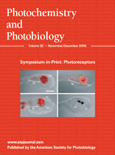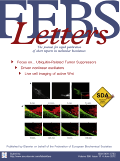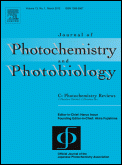
PHOTOCHEMISTRY AND PHOTOBIOLOGY
Scope & Guideline
Exploring the vital role of light in biochemical processes.
Introduction
Aims and Scopes
- Photodynamic Therapy (PDT) and Photobiomodulation:
Research in this area investigates the therapeutic applications of light, particularly in cancer treatment and wound healing, exploring mechanisms of action, efficacy, and optimization of light parameters. - Photochemistry and Environmental Photobiology:
This scope includes studies on the effects of sunlight and UV radiation on biological systems, including plants, microorganisms, and human skin, emphasizing the implications for health and environmental sustainability. - Photosensitizers and Photocatalysis:
Research focuses on the design, synthesis, and application of photosensitizers for photodynamic therapy, antimicrobial applications, and environmental remediation through photocatalytic processes. - Molecular and Cellular Responses to Light:
Exploration of the molecular mechanisms underlying cellular responses to light exposure, including signaling pathways, gene expression changes, and oxidative stress responses. - Innovative Techniques in Photobiology:
The journal promotes novel methodologies and technologies in photobiological research, such as advanced imaging techniques, spectroscopy, and computational modeling.
Trending and Emerging
- Far-UVC and Germicidal Technologies:
With the ongoing focus on public health, particularly in the context of airborne pathogens, research on far-UVC light technologies for disinfection and safety is gaining traction, reflecting increased societal relevance. - Integrative Approaches to Phototherapy:
There is a notable increase in studies integrating phototherapy with other modalities (e.g., drug delivery systems, immunotherapy), enhancing the therapeutic potential and effectiveness of light-based treatments. - Environmental and Ecological Impacts of Light Exposure:
Research examining the ecological effects of UV and visible light on ecosystems, including impacts on microbial communities and plant health, is emerging as a significant area of interest. - Nanotechnology in Photobiology:
The application of nanomaterials and nanotechnology in enhancing photodynamic therapy and photobiological applications is trending, showcasing innovation in treatment delivery and efficacy. - Personalized Phototherapy:
An increasing focus on personalized approaches to phototherapy, where treatment parameters are tailored to individual responses, is emerging, reflecting a broader trend towards precision medicine in photobiology.
Declining or Waning
- Traditional Photochemical Mechanisms:
Research focusing solely on classical photochemical reactions without integrating modern approaches or applications is becoming less prominent, as the field evolves towards more applied and interdisciplinary studies. - Basic Photobiology without Clinical Application:
Basic studies of photobiology that do not link findings to clinical implications or therapeutic applications are seeing a reduction in publication frequency, indicating a shift towards more translational research. - Limited Focus on Non-therapeutic Applications of Light:
Investigations that explore non-therapeutic applications of light, such as basic photochemistry in non-biological contexts, are becoming less common, as the journal emphasizes more impactful and relevant research areas.
Similar Journals

CELLULAR PHYSIOLOGY AND BIOCHEMISTRY
Empowering Discoveries in Molecular BiologyCellular Physiology and Biochemistry is a premier Open Access journal published by the prestigious Cell Physiol Biochem Press GmbH & Co, dedicated to advancing research in the fields of physiology, biochemistry, and molecular biology. Since its inception in 1987 and transitioning to an Open Access model in 2013, the journal has established itself as a vital resource for the dissemination of high-quality research and reviews, showcasing innovative methodologies and groundbreaking findings in cellular processes. With an impressive ranking in the 2023 Scopus category as Q2 in Physiology and a robust percentile of 61, Cellular Physiology and Biochemistry is committed to fostering academic dialogue among researchers, professionals, and students alike. This journal not only provides unrestricted access to its articles, but also promotes the global sharing of knowledge, which is essential for the advancement of our understanding in these vital scientific areas. The journal's editorial team is dedicated to ensuring the highest standards of academic rigor and relevance, making it an indispensable addition to the libraries of those engaged in the life sciences.

BIOCHIMICA ET BIOPHYSICA ACTA-MOLECULAR CELL RESEARCH
Transforming discoveries into impactful science.BIOCHIMICA ET BIOPHYSICA ACTA-MOLECULAR CELL RESEARCH is a premier journal published by Elsevier, dedicated to advancing the fields of cell biology and molecular biology. Established in 1982, this influential journal has been at the forefront of scientific research and innovation, currently holding esteemed positions with a Q2 ranking in Cell Biology and a Q1 ranking in Molecular Biology for 2023, reflecting its commitment to high-quality scholarship. With an impressive impact factor, it ranks in the 82nd and 78th percentiles for Molecular Biology and Cell Biology, respectively, amongst its peers. Researchers, professionals, and students will find this journal to be an invaluable resource for exploring the latest discoveries and methodologies in the molecular mechanisms underlying cellular functions. Although it is not an open-access journal, the insights offered in its pages contribute significantly to the scientific community's understanding of cellular and molecular processes, ensuring it remains a vital platform for disseminating cutting-edge research.

AIMS Biophysics
Bridging disciplines to illuminate the molecular world.AIMS Biophysics, published by the American Institute of Mathematical Sciences (AIMS), is an esteemed open-access journal dedicated to advancing the fields of biophysics, biochemistry, molecular biology, and structural biology. Launched in 2014, this journal provides a platform for researchers and professionals to disseminate high-quality research findings that contribute to the understanding of complex biological systems at the molecular level. With an ISSN of 2377-9098, AIMS Biophysics is indexed in Scopus, where it ranks in the fourth quartile across several categories, reflecting its commitment to addressing important issues within the scientific community. The journal aims to foster interdisciplinary collaboration and innovation through the publication of original research, reviews, and methodologies that advance the field. The open-access model ensures that cutting-edge research is freely available, promoting global access to scientific knowledge and enhancing visibility for authors. Nestled in the vibrant scientific landscape of the United States, AIMS Biophysics is poised to impact the evolving discourse in biophysics and related areas as it continues through its convergence period from 2014 to 2024.

Photobiomodulation Photomedicine and Laser Surgery
Exploring the Intersection of Light and MedicinePhotobiomodulation Photomedicine and Laser Surgery is a premier peer-reviewed journal published by MARY ANN LIEBERT, INC, dedicated to advancing the understanding of light-based therapies in biomedical applications. With an impressive impact factor, this journal occupies a significant position in the field of Biomedical Engineering and Radiology, Nuclear Medicine and Imaging, evidenced by its placement in the Q3 category for both fields as of 2023. The journal's scope encompasses a wide array of research topics, including but not limited to, the therapeutic effects of photobiomodulation and innovative laser surgical techniques. Researchers and practitioners alike can benefit from its open-access format, facilitating the dissemination of cutting-edge findings to a global audience. By bridging the gap between scientific inquiry and clinical application, Photobiomodulation Photomedicine and Laser Surgery plays a crucial role in fostering the integration of advanced technologies in healthcare, enhancing patient outcomes and pushing the boundaries of medical science.

PROGRESS IN BIOCHEMISTRY AND BIOPHYSICS
Unveiling Innovations in Biochemistry and BiophysicsPROGRESS IN BIOCHEMISTRY AND BIOPHYSICS, published by the Chinese Academy of Sciences, Institute of Biophysics, serves as a vital platform for advancing the field of biochemistry and biophysics. With a legacy dating from 1996 through 2024, this journal has been instrumental in disseminating critical research findings and innovative methodologies that push the boundaries of our understanding of biochemical processes and biophysical phenomena. Though currently unlisted as Open Access, the journal embodies rigorous peer-reviewed scholarship, positioned in the competitive Q4 quartile for both biochemistry and biophysics categories as per the 2023 metrics. It caters to a diverse audience, including researchers, professionals, and students who are keen to explore foundational and emerging concepts within these dynamic fields. By publishing comprehensive studies and reviews, the journal not only highlights progress but also fosters collaboration and dialogue among scholars worldwide, making it an essential resource for anyone invested in biochemical and biophysical research.

FEBS LETTERS
Fostering Knowledge Exchange in Life SciencesFEBS LETTERS, published by Wiley, is a prestigious journal that has firmly established its place in the fields of biochemistry, biophysics, genetics, molecular biology, cell biology, and structural biology. With an esteemed history dating back to 1968, this journal continues to be a vital resource for researchers and professionals involved in the biological sciences. It boasts impressive quartile rankings, including Q1 statuses in several categories such as Biochemistry and Genetics, reflecting its high impact factor and significant contribution to scientific discourse. FEBS LETTERS provides a platform for innovative findings and critical reviews, fostering the exchange of knowledge and ideas within the scientific community. Although it operates under a subscription model, the journal ensures broad dissemination of groundbreaking research through its rigorous peer-review process. The vibrant discussions encouraged by articles published in FEBS LETTERS aim to inspire current and future generations of scientists to push the boundaries of biological understanding, making it an indispensable resource for anyone dedicated to advancing their knowledge in these dynamic fields.

JOURNAL OF TRACE ELEMENTS IN MEDICINE AND BIOLOGY
Innovating Insights into Biochemical Functions of Trace ElementsThe JOURNAL OF TRACE ELEMENTS IN MEDICINE AND BIOLOGY, published by Elsevier GmbH, stands as a leading platform for disseminating pivotal research in the interdisciplinary field that bridges biochemistry, inorganic chemistry, and molecular medicine. With an impact factor reflective of its high-quality submissions and significant contribution to the scientific community, this journal currently holds a Q2 ranking in Biochemistry and a Q1 ranking in Inorganic Chemistry, underlining its esteemed status among peers. Since its inception in 1995 and continuing through to 2024, the journal has fostered a dynamic discourse on the fundamental roles of trace elements in biological systems, incorporating studies that range from their biochemical functions to their impact on health and disease. Researchers, professionals, and students alike can access a wealth of knowledge, missing Open Access options notwithstanding, making it indispensable for those at the forefront of scientific investigation in medicine and biology.

JOURNAL OF PHOTOCHEMISTRY AND PHOTOBIOLOGY C-PHOTOCHEMISTRY REVIEWS
Exploring the Synergy of Light and BiologyThe JOURNAL OF PHOTOCHEMISTRY AND PHOTOBIOLOGY C-PHOTOCHEMISTRY REVIEWS, published by Elsevier, is a premier scholarly journal that serves as a critical resource for researchers and professionals in the field of photochemistry and photobiology. With a distinguished Q1 ranking in key categories such as Catalysis, Organic Chemistry, and Physical and Theoretical Chemistry, this journal consistently publishes high-impact articles that contribute significantly to the advancement of knowledge in these disciplines. The journal's rigorous peer-review process ensures the integrity and quality of the research it disseminates. Researchers benefit from its comprehensive review articles that discuss recent advancements, theoretical developments, and practical applications of photochemical processes, making it an essential read for anyone in the field. The journal's impact and relevance are evidenced by its impressive Scopus rankings, including a top percentile of 98th in Organic Chemistry. As the journal continues to explore innovative and interdisciplinary approaches, it stands out as a vital platform for sharing and discussing cutting-edge research findings within the community.

Doklady Biochemistry and Biophysics
Fostering Scholarly Discourse in Biochemistry and BiophysicsDoklady Biochemistry and Biophysics is a vital resource for the advancement of knowledge in the fields of biochemistry and biophysics, published by MAIK NAUKA/INTERPERIODICA/SPRINGER. Featuring an ISSN of 1607-6729 and an E-ISSN of 1608-3091, this journal plays a critical role in disseminating research findings and fostering scholarly discourse. Despite its recent ranking in the Q4 quartile for biochemistry and biophysics in 2023, it serves as an essential platform for researchers exploring these intertwined disciplines. The journal’s scope encompasses a wide variety of topics, enhancing the understanding of biochemical processes and physical principles in biological systems. With converged years of publication from 2001 to 2024, it stands as a continual source of knowledge for its readers, who include researchers, professionals, and students alike. While the journal currently does not offer open access options, its contributions remain significant within the scholarly community, illustrated by its competitive Scopus rankings across related fields.

BIOLOGICHESKIE MEMBRANY
Unveiling the Secrets of Cellular StructuresBIOLOGICHESKIE MEMBRANY is a critical journal in the field of Cell Biology and Molecular Biology, published by MEZHDUNARODNAYA KNIGA in the Russian Federation. With an ISSN of 0233-4755, this journal has been serving the academic community since 1996 and continues to publish cutting-edge research that advances our understanding of biological membranes and their functions. Despite being classified in Q4 quartiles for both Cell and Molecular Biology in the 2023 category rankings, the journal presents a unique platform for emerging research within these pivotal areas. Researchers, professionals, and students alike will find valuable insights in its pages as it seeks to foster a collaborative environment that encourages knowledge sharing. Although currently not available as an open-access journal, it remains an essential resource for those looking to deepen their knowledge and contribute to ongoing discussions in the biological sciences. The journal’s commitment to publishing quality research is underscored by its continuous coverage until 2024, making it a sustained reference in the field.